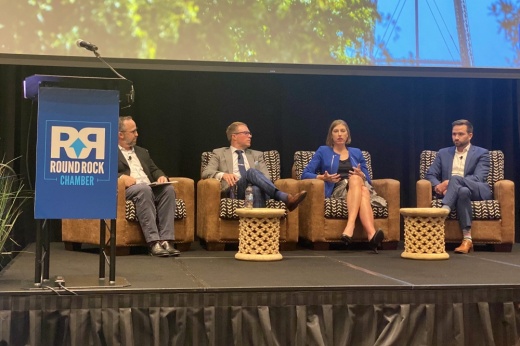Speakers Jeremy Barclay, CEO of St. David's Round Rock Medical Center; Kate Henderson, president of regional hospitals and community partnerships for Ascension Texas; and Drew Bennett, vice president of operations for Baylor Scott & White Medical Center Round Rock, each contributed to the discussion of local health care a little over two years after the U.S. onset of the COVID-19 pandemic in March 2020.
Responses have been edited for length and clarity.
What is something you're proud you've accomplished? If you want to throw in a personal accomplishment too—that's what we do at CI—what's your best professional accomplishment?
Barclay: The very first thing that comes to mind is the word "survive." I mean that in the business sense of surviving, what we're probably going to get into here in a little bit, that the total blowup of everything that we knew as normal, and the whole delivery of patient care, the whole of my job, to totally change all those aspects.
Henderson: Everyone's health care needs have continued to grow, and our communities continue to grow. One of our goals is to get the care that you need closest to where you live, work, play and pray. That involves, in many cases, expanding the breadth and depth of services so that you don't have to drive to another community to get complex care. In the last 24 months, we've also added things like specialized cardiovascular services at Seton Williamson; we've added a broader array of women's health services, including regarding the pelvic floor, specialty care, which again, now means you don't have to drive.
Bennett: We're just continually in awe of our folks that have come through [who] have also helped us evolve to getting to a place of sustainability and remain resilient and still provide our communities have what they need in the face of all these things. Another piece of that that I think we're really proud of, or I'm really proud of, from the organization standpoint is the investment in our workforce over the past year plus. We have almost tripled the number of graduate nurses that we accept in our region here. We have set up partnerships with [Austin Community College], for apprenticeships, for patient tech programs and [certified nursing assistant] programs. We are really trying to make sure that we are meeting the customer where they are in the best possible way. The pandemic really made us realize the value of our app. You can make an appointment straight from the app with any of our providers. [You] don't even have to have been an established patient, which is a new feature that we introduced during the pandemic.
Are we in the endemic? Or are we still in the pandemic? I don't mean this to be political. But as you guys start preparing your hospitals, how do y'all approach that?
Barclay: With the information that has been presented, I would say yes, we're on to the endemic stage. How are we adjusting? You know, Mr. Bennett mentioned several of the telemedicine video visits; I thought that was a really clever way to say it. Those certainly went up significantly. And I think the end user of our products that we produce, they really got used to that and really liked that. I think that means more technology and probably catching up to where we probably needed to be years ago. I think there have been a lot more of those platforms going across with things that were never out there previously.
Henderson: We believe it's endemic. COVID-19 is a new disease category, and it will have its iterations, which we've seen. Most of the time when we find COVID-19 as Kate Henderson's presenting today to have a her knee replaced, and we test her before surgery. So we have her results. Oh, and by the way, she's also COVID positive. So it's incidental to what my real presentation was. That's how most of it's presenting today. That said, I would encourage all of you to follow [Centers for Disease Control and Prevention] guidelines and go get your vaccinations.
Bennett: [I] very much agree with what's been shared thus far and also have to plug in there that it's in a kind of normalcy state as far as how we're figuring out how to operate with COVID moving forward. However, it is very important that we, you know, maintain that COVID is very much still there as far as the number of cases that are happening. We know the things to do to help prevent [it].
Are we going to see the way that hospitals, how the the beds are utilized, is that going to change as well?
Henderson: We're continuing to expand and anticipate being able to nearly double the size of our campus in the relatively near future. But the way we'll think about how that's constructed, what those hospital beds can do, will be less prescribed and just more [that] there's a bank of hospital beds, and so that as the community's needs change, and as new diseases emerge, we can use those spaces for a host of things and related platforms. We recently opened the sixth floor of Ascension Seton Williamson in the last six to nine months. We thought it was going to be needed for one patient group. As we saw more patients coming in our emergency department or physician's offices, we were up in just four different patient groups.
Bennett: As we're planning expansion of our hospital campus to keep up with the growth of this area, we're doing the same exact thing space we're talking about. We actually call it a universal bed concept, where we are planning, at least from a physical infrastructure perspective, to see all those different levels of care and that we really do have that flexibility to thrive, what needs to be in an inpatient setting there, have the right care as far as staffing and all those things.





